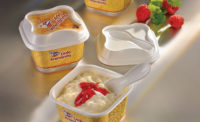
Securely Contained
by Shonda Talerico Dudlicek
Demands broaden on the development of packaging for food safety.
Food safety is a hot topic,
no doubt about it. From allaying consumers’ fears to tamper-evident
packaging, caps and seals, to bioterrorism and legislation, there is a lot
to talk about.
This month, we invited several suppliers of packaging
and related components to the dairy industry to weigh in on this broad
topic.
Q: What are the latest technology and trends in
packaging for food safety?
Chuck Ravetto, director of small character marking,
Videojet Technologies Inc., Wood Dale, Ill.: The
ability to track product both upstream and downstream in the supply chain
has become critically important during this decade, primarily due to the
federal Bioterrorism Act. Thus, the demand to add further information to a
variable data code for increased traceability has grown.
Roy Robinson, vice president, strategic marketing,
Portola Packaging Inc., Batavia, Ill.: The local
and state enforcement of the FDA tamper-evidence testing protocol continues
to identify gaps in many dairies.
Dale Berg, general manager, Blackhawk Molding Co. Inc.,
Addison, Ill.: We recognize it as a major issue
in food safety. We are evaluating additional innovations that will promote
food safety while also implementing the need for reducing the environmental
effects of too much packaging material being used in the system. This goal
has been effectively communicated by such companies as Wal-Mart.
Murray Bain, vice president of marketing, Stanpac Inc.,
Smithville, Ontario, Canada: Common approaches
to food safety have focused on adding secondary features to the package,
including products such as neck bands and safety seals. These features
require additional equipment and floor space that is always at a premium.
Line speed is often limited and increased waste a factor due to equipment
inefficiencies.
Jacques Carten, marketing manager, IPL Packaging,
Saint-Damien, Quebec, Canada: Packaging plays a
critical role in food safety. Making sure that food content remains
untouched and contamination-free between the manufacturing line and the
end-user is what continues to make food safety so important. Hence,
packaging plays a critical role in this chain, because it transports the
food content that the company wants to sell — it is like a vehicle
and before investing in one, proof must be obtained that it will go from A
to B safely — to the end-user.
Tamper evidency is essential, whether the packaging is
equipped with a break tab or a tear strip, for larger containers, the
packaging has to put the retailer and the end user in confidence about the
safety of the content.
Nadia Vizza, marketing manager, Polypack Inc., Pinellas
Park, Fla.: It is important to take into
consideration product from creation to the day of its arrival on the shelf
of a store. Primary packaging is important for the freshness of the
product; the secondary and tertiary packaging is more about
multipacking and handling during distribution.
Q: What do consumers demand in packaging for food safety?
Giovanna Prestes Lemos, marketing and communications
manager, Tetra Pak Inc., Vernon Hills, Ill.: Safety
is a key consideration with regards to food and beverage packaging. Food
safety has become a big concern of consumers over the past couple years.
When consumers choose a product, they are also choosing the package it
comes in. In today’s fast-paced society, consumers crave convenience
and quality and at the same time want a package that keeps the product
fresh and safe.
According to a study conducted by Food Mix that
involved a series of consumer focus groups and an Internet survey of 6,500
consumers responsible for food purchase, nine key issues impact a
consumer’s evaluation of packaging. The concept of protection leapt
to the top, and consumer concerns centered on packaging qualities that
protect food from spoilage. Consumers pinpointed this issue as their number
one concern.
In addition, consumers cited safety — and the
ability of a package’s potential to hurt or harm the consumer or a
family member. For consumers, the safety issue does not involve the product
inside the package but the package’s likelihood to break, shatter or
have sharp edges that might cut a finger.
Berg: Customers’
demands have basically been simple. They want the following: a package that
does not leak; color coding of the bottle to signify the type of product;
and a package with a screw cap that will reseal the bottle.
Historically, tampering has not been a serious issue to
consumers. We believe this will change when the consumer has the
opportunity to choose a package that will clearly demonstrate [if there
has been] tampering.
Ravetto: Consumers want safe
products with information on the freshness date of a product. The recent
lettuce and spinach recalls are changing the way customers think about and
view food safety.
Consumers are now more concerned about both product
safety and freshness — for example, “best before” or
expiration dates. Previously, customers were most interested in
freshness-date information.
As a result, variable data codes are becoming more
readable to the customer instead of just the manufacturer, along with
containing more information for product traceability. Codes are also used
to promote brand recognition.
David Love, general manager of Farmingdale, N.Y.-based
Seal-It Inc., a division of Printpack Inc., Atlanta: Tamper-evident bands also need to have easy-open access so
consumers can open the product. There are different types of perforations
and tear strips. It’s a reassurance for customers. When the seal is
under the cap, they have to buy it and take it home to see if it’s
tampered with, then they either have to bring it back to the store for
refund or throw it away. Once the bands are broken they could be back but
the result is clear that someone has been tampering with it.
When I go to the store, when there is not a
tamper-evident seal on the package, if I realize one corner is pulled up,
then I wonder how long has it been here? Is it a manufacturer’s
defect or did someone put something in it? It’s on most
consumers’ minds that they want that security. When you have things
like the E. coli
outbreak in spinach, it makes consumers wary of buying from the shelf. We
want them to know that we have good products. And there have been a number
of consumers’ studies that show they want that. They show concerns.
Bain: Consumers are most
comfortable purchasing products that make them feel they are making a safe
choice for themselves and their families. Because people have so little
time these days they tend to make choices based on what they already know
or can see first hand. Visual tamper evidence plays an important role in
making these choices. If a tamper-evident feature is not clearly visible at
point of purchase, the consumer will not find out if the package has been
compromised until the package is opened at home and then must be returned
to the store. This hassle factor can be eliminated if a tamper-evident
feature is visible at point of purchase.
As the years go by more and more of the products in
stores have packaging that has a form of tamper evidence to satisfy the
consumers’ needs and also to protect against huge potential liability
issues. Even things are changing in the fresh vegetable department, with
many products sold in sealed bags or containers. The ice cream cabinet is
one of the last frontiers where there is still a lot of work to be done.
Q: What are dairy processors asking for and what
services are in demand in packaging for food safety?
Carten: We believe that
dairy processors are looking for efficient solutions that will not
compromise the safety of their product. There’s great benefit for the
processors when they can offer content security without having to deal with
the application of an additional seal or shrink band. IPL has a lot of
success with its rigid plastic packaging products with built-in tamper
evident system. Many food processors are now offering tamper-evident
packaging as an added value to their product.
Love: It’s more
popular for processors to do a full sleeve, because if you’ve got to
buy a label and a separate sleeve with a tamper-evident band, then
it’s one stop for putting a label on a sleeve.
Michelle Schmitt, market analyst, Berry Plastics Corp.,
Evansville, Ind.: Sustainable packaging —
Wal-Mart’s recent focus on the sustainability and the environment has
shifted the focus to “greener” packaging.
Robinson: Dairy processors
are asking us to work with them and their bottle suppliers to ensure their
products will pass the FDA protocol. In addition, with the recent national
attention on food safety, some retailers are challenging suppliers for more
food safety packaging innovations. The dairy processors are also requiring
efficient filling and capping operation on any new products.
Bain: Tamper evidence is
presently a necessity for Grade A products in the dairy industry. Most
processors look for equal or improved line efficiencies and desire the cost
to be as close to existing non-tamper-evident products as possible. All
other products are basically self-policed as far as food safety is
concerned and not required by law, however, with safety and liability issue
coming to the top of processors minds many are seriously considering a
feature of some sort.
Ravetto: Dairy processors
desire the ability to print more “real-time” information
without impacting production efficiencies. Added information within a
variable data code allows processors to track a product’s
ingredients all the way back to the farm.
Shonda Talerico Dudlicek is a freelance journalist and
a former managing editor of Dairy Field.
$OMN_arttitle="Securely Contained";?>
$OMN_artauthor="Shonda Talerico Dudlicek";?>
